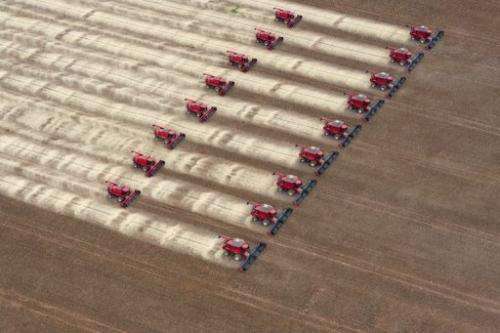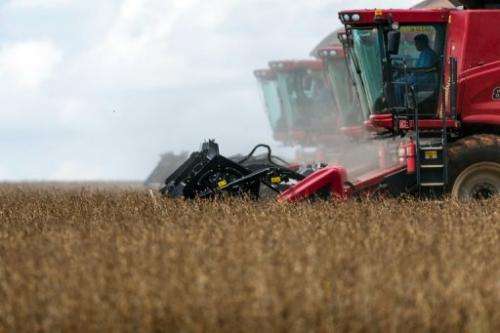China demand fuels record soy crops in South America

Soy fields stretch as far as the eye can see in South America's fertile plains, boosted by a jump in demand from China and Europe.
With more than 82 million tonnes harvested this year, Brazil is jostling for first place as a producer with the United States, hit by a drought, according to US Department of Agriculture figures.
"Soy brings in the money. It has the nutritional value of meat but it's vegetarian. And it's the cheapest protein in the world to produce by mass," explained soy expert Marc-Henry Andre.
"Up until now, the supply has increased sharply. But the demand has grown even more, which explains why the price for a tonne of soy exceeded $100 in the early 2000s and is now above $500," said Argentine economist Luciano Cohan.
China imports soy beans at the rate of 60 million tonnes for 2012-2013 and an expected 70 million for 2013-2014.
It then transforms the soybeans into oil or flour, while European countries tend to purchase soybean meal to feed industrially-raised chickens, pigs and cattle.
South American soy is mostly genetically modified but Cohan insisted that was not cause for controversy.
"This is not the subject of much debate. The benefits to the government are so great that it is considered a net benefit," he said.
The soy boom owes much to US seed giant Monsanto, which marketed in 1996 a GMO soy variety resistant to glyphosate, a powerful, broad-spectrum herbicide.
"Soy plays a major role in current farming practices," said French agronomist Marcel Mazoyer. "A cow fed soybean meal produces significantly more milk than a hay-fed cow."

Environmental groups condemn the focus on the crop at the expense of livestock farming and wheat, deforestation, the aerial spraying of pesticides and water pollution.
Brazil has matched US production because new lands have been cultivated for soy crops, sometimes encroaching on forests, namely in the cerrado plateau region home to the country's soy powerhouse Mato Grosso state.
But converting to all-soy crops, which require little manual labor, also bears an important social cost. Small farmers have fled the fields for the already overpopulated big city favelas.
In Brazil, soy is the third biggest export product (11 percent), behind minerals and oil.
Thanks to a push from "Brasiguayos" Brazilian farmers in Paraguay, soybean meal and oil production there has quadrupled in a single year.
This tiny country of just seven million people, niched between Brazil and Argentina, is now the world's sixth largest producer and fourth biggest exporter after Brazil, the United States and Argentina.
In Argentina, this year's harvest was not a record but soy already accounts for a quarter of exports and is a major driver of the economy.
Next year's harvest is set to be the greatest ever, with a projected 53.5 million tonnes.

Argentina's farmers, often millionaires, protest the government's big tax burden—35 percent on soy exports—and as a result did not plant as much as they could.
They retort that Argentina emerged out of its economic crisis in 2001 thanks in large part to soy's jump in the markets.
South America is seeing record harvests and 2013-2014 forecasts say the region's production will increase even further, according to UN Food and Agriculture Organization soy expert Peter Thoeness.
Argentina's "soybean king" Gustavo Grobocopatel expects soy to continue its growth over the next 10 to 15 years before leveling off.
Mazoyer said soy production will double over the next half-century.
"For sure, demand for meat will increase. Soy production must increase even faster than the population in order to meet this demand for meat. The more people eat meat, the more we need corn and soy to feed the animals."
At this pace, "we will have to clear out part of the Amazon forest."
© 2013 AFP


















